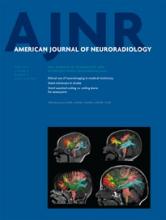Index by author
Caire, F.
- NeurointerventionYou have accessEndovascular Treatment of Middle Cerebral Artery Aneurysms for 120 Nonselected Patients: A Prospective Cohort StudyB. Gory, A. Rouchaud, S. Saleme, F. Dalmay, R. Riva, F. Caire and C. MounayerAmerican Journal of Neuroradiology April 2014, 35 (4) 715-720; DOI: https://doi.org/10.3174/ajnr.A3781
Campbell, B.C.V.
- FELLOWS' JOURNAL CLUBBrainOpen AccessDWI Reversal Is Associated with Small Infarct Volume in Patients with TIA and Minor StrokeN. Asdaghi, B.C.V. Campbell, K.S. Butcher, J.I. Coulter, J. Modi, A. Qazi, M. Goyal, A.M. Demchuk and S.B. CouttsAmerican Journal of Neuroradiology April 2014, 35 (4) 660-666; DOI: https://doi.org/10.3174/ajnr.A3733
The implications of the reversal of DWI abnormalities in patients with TIA and minor strokes were assessed. Patients were imaged within 24 hours of symptoms and followed for 3 months and baseline and final infarct volumes were calculated using DWI and FLAIR, respectively. Over 55% of patients had DWI lesions and 37% had perfusion deficits. DWI reversal occurred in 6% of patients with lesion volume being considerably smaller than in those that did not reverse. Perfusion abnormalities were less common in reversible lesions as well. The authors concluded that DWI lesion reversal is uncommon and more likely with smaller lesions.
Cardinal, J.S.
- Pediatric NeuroimagingYou have accessDiffusion Imaging for Tumor Grading of Supratentorial Brain Tumors in the First Year of LifeS.F. Kralik, A. Taha, A.P. Kamer, J.S. Cardinal, T.A. Seltman and C.Y. HoAmerican Journal of Neuroradiology April 2014, 35 (4) 815-823; DOI: https://doi.org/10.3174/ajnr.A3757
Carroll, K.
- FELLOWS' JOURNAL CLUBNeurointerventionOpen AccessStent-Assisted Coiling versus Coiling Alone in Unruptured Intracranial Aneurysms in the Matrix and Platinum Science Trial: Safety, Efficacy, and Mid-Term OutcomesS.W. Hetts, A. Turk, J.D. English, C.F. Dowd, J. Mocco, C. Prestigiacomo, G. Nesbit, S.G. Ge, J.N. Jin, K. Carroll, Y. Murayama, A. Gholkar, S. Barnwell, D. Lopes, S.C. Johnston and C. McDougall on behalf of the Matrix and Platinum Science Trial InvestigatorsAmerican Journal of Neuroradiology April 2014, 35 (4) 698-705; DOI: https://doi.org/10.3174/ajnr.A3755
These authors analyzed data on 131 non-selected MCA aneurysms treated during a 6-year period. One month after treatment, permanent morbidity and mortality was 3.3% without significant differences according to technique used. The rate of recanalization was nearly 16%, also without differences according to technique, and re-treatment was needed in 7.6% of cases. A greater rate of complications occurred with balloon remodeling and only large aneurysm size predicted recanalization. The authors concluded that endovascular treatment of MCA aneurysms is safe, effective, and durable.
Castillo, M.
- EditorialsYou have accessThinking in Different DirectionsM. CastilloAmerican Journal of Neuroradiology April 2014, 35 (4) 615-616; DOI: https://doi.org/10.3174/ajnr.A3647
Chapman, P.
- EDITOR'S CHOICEHead and Neck ImagingYou have accessSpontaneous Lateral Sphenoid Cephaloceles: Anatomic Factors Contributing to Pathogenesis and Proposed ClassificationF. Settecase, H.R. Harnsberger, M.A. Michel, P. Chapman and C.M. GlastonburyAmerican Journal of Neuroradiology April 2014, 35 (4) 784-789; DOI: https://doi.org/10.3174/ajnr.A3744
Imaging findings in 26 patients with spontaneous lateral sphenoid cephaloceles were studied. The authors were able to classify these lesions into those involving the lateral recess of the sphenoid sinus that typically manifested as CSF leaks and headaches, and a second type that involved the lateral sphenoidal wing without extension into the sinus and presented with a variety of findings including seizures, headaches, meningitis, or neuropathy, or were incidental. All patients showed sphenoid arachnoid pits and 61% had an empty or partially empty sella.
Cheshier, S.
- Pediatric NeuroimagingYou have accessTime-Dependent Structural Changes of the Dentatothalamic Pathway in Children Treated for Posterior Fossa TumorS. Perreault, R.M. Lober, S. Cheshier, S. Partap, M.S. Edwards and K.W. YeomAmerican Journal of Neuroradiology April 2014, 35 (4) 803-807; DOI: https://doi.org/10.3174/ajnr.A3735
Choudhury, K.R.
- Head and Neck ImagingYou have accessAn Exponential Growth in Incidence of Thyroid Cancer: Trends and Impact of CT ImagingJ.K. Hoang, K.R. Choudhury, J.D. Eastwood, R.M. Esclamado, G.H. Lyman, T.M. Shattuck and X.V. NguyenAmerican Journal of Neuroradiology April 2014, 35 (4) 778-783; DOI: https://doi.org/10.3174/ajnr.A3743
Christodoulou, E.
- Review ArticlesOpen AccessRaise the Bar and Lower the Dose: Current and Future Strategies for Radiation Dose Reduction in Head and Neck ImagingM. Ibrahim, H. Parmar, E. Christodoulou and S. MukherjiAmerican Journal of Neuroradiology April 2014, 35 (4) 619-624; DOI: https://doi.org/10.3174/ajnr.A3473
Churilov, L.
- EDITOR'S CHOICEBrainYou have accessThe Impact of Arterial Collateralization on Outcome after Intra-Arterial Therapy for Acute Ischemic StrokeS. Seeta Ramaiah, L. Churilov, P. Mitchell, R. Dowling and B. YanAmerican Journal of Neuroradiology April 2014, 35 (4) 667-672; DOI: https://doi.org/10.3174/ajnr.A3862
The presence of poor leptomeningeal collaterals as assessed by CTA was correlated with patient outcome after receiving intra-arterial treatment for stroke. Functional outcomes in 87 patients with MCA and/or ICA occlusions were retrospectively assessed at 3 months. The authors found that poor arterial collateralization was associated with poor outcome after adjustment for recanalization success. They recommend that future studies include collateral scores as one of the predictors of functional outcome.








